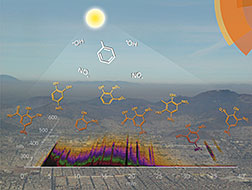- Number 451 |
- November 2, 2015
The color of haze

Urban pollutants work together to form the
brownish particles seen over major cities
the world over. Image reproduced by
permission of PNNL and the Royal Society
of Chemistry in PCCP 17:23312.
Flying into the major airports in Mexico City, Beijing, or Los Angeles on a sunny day, you can see a lingering brown haze over the cityscape. This haze is more than an eyesore. It contains thousands of chemicals that act as a warming blanket, absorbing the sun's rays and trapping heat over the city. To deal with this haze, scientists need to understand the formation and behavior of the chemicals that form the particles. At DOE's Pacific Northwest National Laboratory, a team of scientists examined the particles that form in the atmosphere through reactions involving the pollutant toluene.
They decided to make, measure, and model the particles that belong to a broader group called brown carbon. John Shilling and Jiumeng Liu created particles by mixing the toluene with nitrogen oxides and other chemicals inside PNNL's environmental chamber. They flashed the resulting gas with light, mimicking the natural formation and aging process.
They sent the aerosol material to Alex Laskin, Julia Laskin, and Peng Lin. Using resources in EMSL, the Environmental Molecular Sciences Laboratory, a DOE user facility located at PNNL, they examined the particles' molecular structures and optical properties. The structures and properties determine if the particles absorb or reflect sunlight. With the results in hand, Shawn Kathmann used theoretical chemistry models to show how the specks take in light.
They found that adding a bit of nitrogen oxide, released in combustion engine car exhaust, resulted in particles that absorb visible light. Increasing the nitrogen oxides level led to particles that absorb significantly more light and cause the mix to turn brown.
This study starts to build the roster of players forming the brown haze and lets scientists better predict the properties of other "brown" particles. It could lead to better predictive models to inform future decisions about energy production and use. This work was sponsored by Laboratory Directed Research and Development funds of Pacific Northwest National Laboratory.
Full Story at: http://www.pnnl.gov/science/highlights/highlight.asp?id=4098.
[Greg Koller, 509.372.4864,
greg.koller@pnnl.gov]
